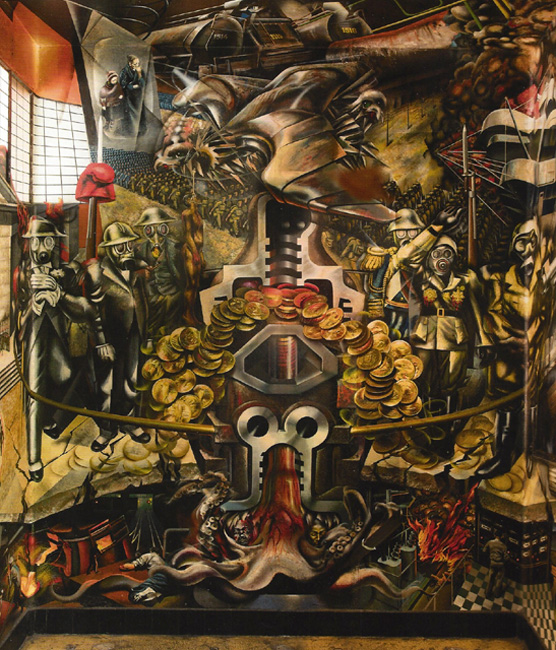Source: WTL photograph© at the Special Exhibition of "Paint the Revolution: Mexican Modernism 1910 - 1950," at the Philadelphia Museum of Art, December 13, 2016.
Image:
This photograph was taken in the Philadelphia Art Museum exhibition of a reproduction of a complex mural titled "Portrait of the Bourgeoisie" (1939-40) by David Alfaro Siqueiros, Luis Arenal, Antonio Pujol (1913-95), and Josep Renau (Spanish, 1907-82). Pyroxylin on cement and glass.
Comments: According to the Spanish muralist José Renau, the theme of the central panel of the lower tryptych is: "a monstrous mechanism, crowned by the eagle of imperialism, continues the general function of capitalism, transforming the blood of the worker--who makes up the infra-structure of the current economic system--into torrents of gold that feed the different forms of global imperialism, generator of war." Elements to find in this panel: at the bottom, in a cavern below a concrete floor, an octopus-like creature with tentacles holding severed heads; in the middle we see a cut-away machine guarded on either side by uniformed gas-masked soldiers that is churning out gold coins made--like an alchemical process--from the (red) blood of what the political comment would identify with exploited workers; and just below black train oil tanker cars is a two-headed eagle that is meant to represent two imperialist powers (note that the three soldiers in the middle on the left apparently suggest Western Allied nations (in World War I) and the three on the right represent the Axis nations of Japan, Italy, and Germany.
Humanities Questions: (A) Admitting that the following question borders on the outlandish, do you think there is a point of comparison between this panel and the Aztec statue of Coatlicue? (B) Focus on a tiny detail in the upper left: in the panel's cluttered, complex imagery, how do you interpret the to figures that seem to be witnessing the chaos in front and below them?


